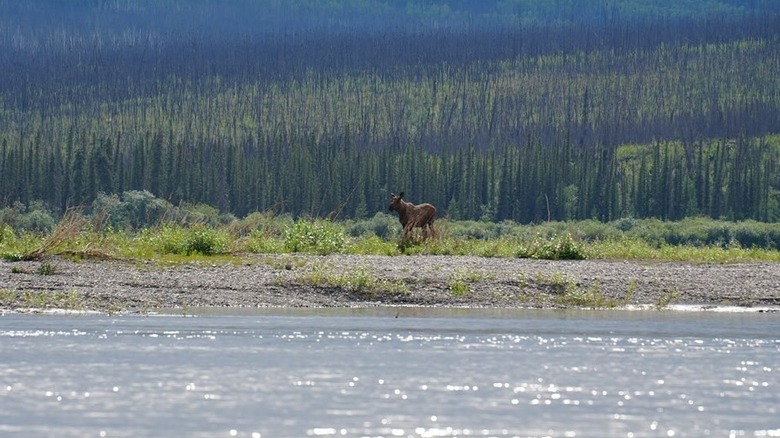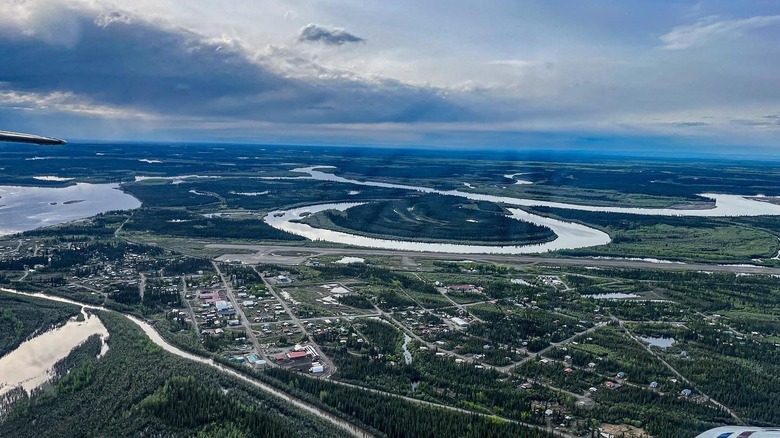The Only Place In Alaska To Ever Reach 100 Degrees Is A Thrilling Summer Recreational Paradise
With its range of snow-capped peaks, sprawling glaciers, fertile farmland, and an astonishing 34,000 miles of winding shoreline, Alaska's landscape stretches farther than any other U.S. state. It's a place where natural beauty and rugged wilderness invite travelers seeking breathtaking parks, mountains, and abundant wildlife. Tucked deep within this vast terrain is the remote village of Fort Yukon, far from the state's coast and surrounded by wilderness.
Perched on the banks of where the Yukon and Porcupine Rivers meet in the Yukon Flats region, the community sits above the Arctic Circle and endures long, cold winters and short, warm summers. In fact, Fort Yukon holds the state's hottest recorded temperature at 100 degrees Fahrenheit in 1915. While that's far from the norm, summer highs in the area often hover above 57 degrees Fahrenheit, making it a prime season for outdoor activities like fishing and boating.
Before Fort Yukon became a destination for summer adventure, it was, and still is, home to Indigenous communities. Among them are the Gwich'in tribe, who have been in the lowlands of the Yukon Flats for generations. The area's abundance of animals made it a strategic location for a fur trading post in the 19th century. Fort Yukon played a key role in the region's economy, fueled by the fur industry, whaling along the Arctic coast, and the gold rush era. Over time, it evolved from a trading post into a more established settlement and gained essential services, including a post office, hospital, and electricity.
Exploring Fort Yukon's arctic wildlife and Indigenous culture
Fort Yukon sits within Yukon Flats National Wildlife Refuge, one of the largest in the U.S. Offering front-row seats to some of the most diverse wildlife, nature lovers will have the opportunity to see everything from moose and bears to wolves, river otters, and hundreds of bird species. The area also shelters millions of waterfowl and is home to Alaska's endemic fish, the Bering cisco. Experienced travelers can paddle through its rivers by canoe, kayak, or raft, while those seeking guidance can join organized tours to navigate the waterways. For a different perspective, scenic flights by air taxi or private planes offer aerial views of the surrounding wilderness and possibly glimpses of caribou herds roaming below. Travelers opting for a flight should also consider visiting the nearby Arctic National Wildlife Refuge, which is accessible mainly by air and is a renowned Alaskan paradise is full of wildlife and pristine beauty.
Beyond its natural landscape, visitors can engage with the local Indigenous community, as Fort Yukon has the largest Athabascan village in Alaska. The city's population is more than 500, most of whom belong to the Gwich'in tribe. A visit here offers a chance to connect with a culture whose relationship with the land spans centuries. In the winter, Fort Yukon showcases spectacular views of the northern lights. Alaska is one of the best places to witness the aurora viewing, and Fort Yukon's location above the Arctic Circle, far from light pollution, makes it especially ideal. Even NASA has recognized the area's clear, dark skies, using the city as a research site to study the natural phenomenon.
Journeying to Fort Yukon
Reaching Fort Yukon is part of the adventure because there aren't many paved roads leading into the city. Most travelers arrive by plane at the small Fort Yukon Airport, which handles only domestic routes. The best option for international visitors is to fly into Fairbanks International Airport first. From there, it's a short flight of a little over 140 miles to Fort Yukon. Along the way, the scenic flight will offer sweeping views of Alaska's vast wilderness, giving travelers a preview of the beauty that awaits.
Once you land, be prepared for a city with minimal services for tourists. Fort Yukon has no hotels or motels. The only lodging option is the Snowdrift Bed and Breakfast, a guesthouse that's been welcoming visitors since 2010. Located near the city's main street, it offers two room types: single occupancy for $80 per night and double occupancy for $120. With only one place to stay, it's essential to make a reservation early. For more accommodations, consider staying in Fairbanks and planning a day trip or short overnight visit to Fort Yukon by plane. You can even get the full Alaskan experience by staying at the Chena Hot Springs Resort, offering summertime activities and northern light view during the winter. Whichever you choose, a visit to Fort Yukon will offer an incredible experience that few travelers ever get to encounter.


